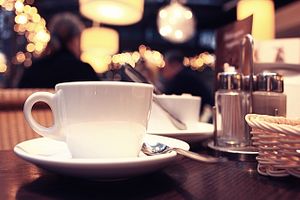Finding a great cup of coffee isn’t easy in a country that produces more tea than any other nation, but an increasing number of shops are catering to the discerning customer.
“We started the café because we saw a lack of good coffee in Hong Kong at that time,” John So told me, director of the Hong Kong café 18 Grams. He said the shop began as an Australian style café — a specialty espresso bar with a good breakfast menu. Today they also use vacuum coffee, Chemex, Hario V60 and AeroPress brewing methods.
“Our approach was to simply make the best coffee possible at all times,” he explained. “Many people don’t recognize the difficulty in making a good cup of coffee.”
This is probably true the world over, though particularly in China, where per capita coffee consumption is only about one cup per year, less than one percent that of South Korea, which in turn is only 35 percent of U.S. consumption. Yet with 256 locations, Shanghai is the third most Starbucks-filled city in the world, following Seoul with 284 locations and New York with 277. So how does a coffeehouse chain thrive in a nation that scarcely drinks coffee? Max Magni and Yuval Atsmon of Harvard Business Review write, “Starbucks has done well in China partly because of its snob appeal.”
The relative cost of a grand latte in China, adjusted to per capita income, is $27. This is according to Matt Schiavenza, who in his article “Why Is Starbucks So Expensive in China?” quotes public relations expert David Wolf’s explanation:
Transporting coffee beans from, say, Colombia to the port of Tianjin is about the same as transporting them from Colombia to the port of Los Angeles. It’s getting them from the port in Tianjin to the store in Beijing that’s expensive.
In addition to poor infrastructure, Schiavenza cites “taxes, fees, and middle-men” as what goes into “marked-up frappuccinos and lattes.” But the mark-up hasn’t priced it out of the market. It’s turned Starbucks coffee into a means for nouveau riche to flaunt their wealth. This is often taken to an extreme in China, where for example one can find a BMW, Ferrari, Lamborghini or stretched limo wrapped in gold. For tuhao, a term denoting the vulgar rich, Starbucks is the place to see and be seen. I once saw a man lay two stacks of banknotes on the Starbucks counter, place his order, then approach tables and gesture at patrons with his money, ostensibly to see if they would soon be leaving.
Another reason for its “snob appeal” is that Chinese coffee culture reached the third wave (artisanal, single-origin brews) early on. The first wave, typified by Folgers and Maxwell House, came to China with the entry of Nestlé in 1990. Starbucks brought the second wave nine years later. Instant coffee still makes up 80 percent of China’s coffee market, according to a China Briefing report, but the third wave is already finding its footing. It’s not easy though. As the report notes, Chinese have yet to acquire a taste for coffee’s bitterness. Nestlé products “include sugar and powdered milk,” Starbucks “emphasizes milk-based drinks like frappucinos” and often when I order an Americano, I’m asked whether I want milk or sugar, which would, of course, defeat the purpose.
John So, a true third wave aficionado, alludes to the presence of terroir in every cup and stresses the skill needed to make a fine brew. His passion is proof that coffee isn’t just a means of conspicuous consumption in China, and his focus on terroir speaks to the value of the land, and the people who work it. Coffee came to China in 1892 when a French missionary planted seeds near his church in the village of Zhukula, Yunnan, where ethnic Yi farmers continue to cultivate it today. This province, famous for its Pu’er tea, constitutes “nearly 98 percent of the country’s total coffee production.” It’s a boon for local farmers. China’s coffee consumption grows 15 percent annually, compared to 2 percent globally, and with a hectare of coffee, a family can make “triple the amount for tea, and five times more than for maize or rice.”
Starbucks and Nestlé aren’t alone either. KFC, China’s largest food chain, plans to offer premium coffee at half the cost of a Starbucks cup in 2,500 locations (Starbucks has 1,500 locations). This will greatly expand China’s coffee culture, though there’s already a growing number of coffee lovers.
“While most local customers are slowly picking up on what we are trying to do,” says John So, “those who understand really appreciate it. These are our main customers, those who are in a coffee shop to enjoy the coffee.”
































